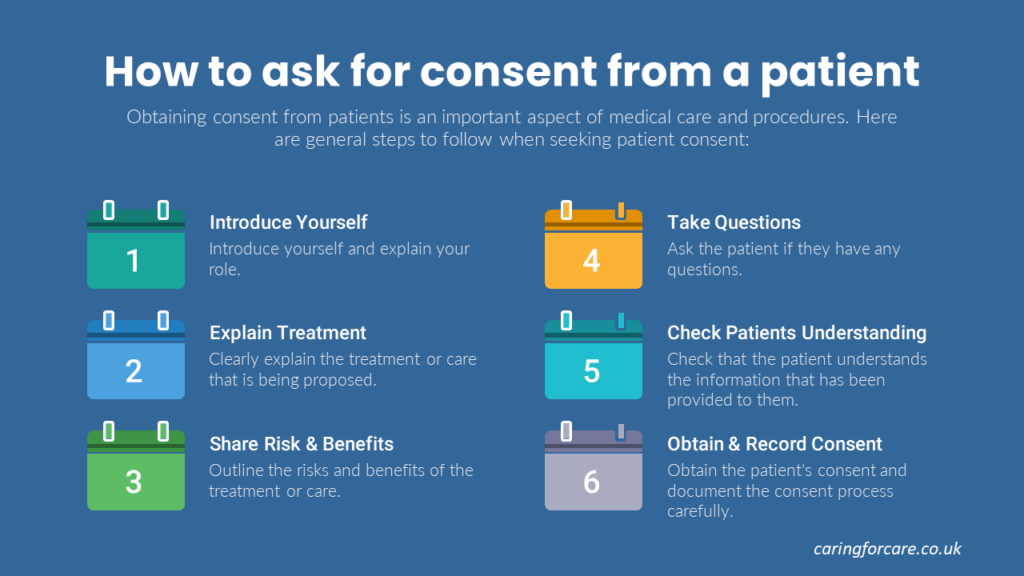Patient Consent: Better Ways to Obtain Patient Approval as a Healthcare Worker.
Getting proper consent can be tough when healthcare providers have busy schedules and patients want to get on treatment.
However, knowing the function of consent yields productive collaboration, safer care decisions, and required patient empowerment regarding health matters.
This article discusses the various individuals who are affected by healthcare consent rules – care assistants, nurses, nurse practitioners, healthcare assistants, and patients or family members who support treatment decisions.
Contents Covered Here
In clear terms, this piece will help clarify:
- The precise definition of patient consent in medical situations.
- Determining legal capability to provide patient consent.
- Recommended procedures preceding agreement to healthcare interventions.
- Real-life examples of smoothly-obtained or complicated medical consent.
- Advice for upholding ethical consent amid hectic clinical environments.
Our intention is to explain how sound consent protocols protect patients while also easing frustrations for time-constrained staff dedicated to compassionate care delivery.
I. Understanding the Basics of Patient Consent
Now that we’ve introduced the central importance of patient consent in healthcare, let’s dig deeper into some key foundations.
This includes unpacking exactly how consent gets defined in medical contexts, what laws and ethical codes have to say about it, and distinctions between types like informed vs implied consent.
Grasping these core concepts clearly is crucial for putting consent competently into daily practice.
II. Defining Patient Consent:
So, what exactly constitutes consent in a general sense? Patient consent refers to a patient’s voluntary, informed permission, agreement or authorisation regarding healthcare treatment, services, or procedures.
Breaking this down further:
- Permission – The patient says yes to allow something.
- Voluntary – Agreement is offered freely without coercion. External pressure invalidates real consent.
- Informed – The patient fully understands risks, benefits, and options through conversation.
- Healthcare treatment – Applies to any medical intervention from lifting to surgery.
Thus, medical consent relies on patients having enough:
- mental capability,
- disclosure,
- comprehension, and
- free will to approve clinical activities affecting their bodies with adequate understanding of what said approval permits.
Many factors can undermine capacity to process choices like:
- confusion/anxieties,
- learning disabilities,
- dementia,
- sedation, or
- mental illness.
However healthcare teams should presume competence unless or until sufficient evidence proves otherwise case-specifically.
Why Patient Consent Matters – Legal and Ethical Obligations:
Seeking patient agreement for tests, treatment and touch remains an ethical obligation codified legally across UK law, professional guidance and human rights doctrines.
Key principles include:
- Respecting patients’ right to guide their own care aligns with principles such as the Universal Declaration of Human Rights and the Oviedo Convention. Compulsion goes against these fundamental civil liberties.
- Clinical codes of practice mandate consent as component of ethical healthcare provisions. Regulatory bodies can sanction providers for serious or systemic consent failures.
- Statutes like the Mental Capacity Act establish consent-related rights in case of impaired patient capacity.
- Potential claims of assault or negligence arise when practitioners proceed absent consent or adequate communication of material risks. Damages or malpractice consequences can result.
In essence, consent consent is legal permission that sets apart regular care, tough decisions, and accidental results from wrongly denying self-decision.
Patients have the right to what goes into their bodies, and healthcare providers must respect this both ethically and legally through consent practices, or they may face consequences.
Thus, appropriate training and adherence proves essential.
The Bolam Case and What It Means for Healthcare Staff
Mr Bolam was a patient who went to hospital for treatment for mental illness problems.
He agreed to have some electric shock treatment to try fixing his condition.
But he didn’t know that part of this treatment sometimes made patients move suddenly and violently during the procedure.
And no one had told Mr Bolam about this risk or offered any restraints to keep him safe.
Unfortunately, during a therapy session, Mr. Bolam badly hurt himself with uncontrolled, violent jerking.
Mr Bolam decided to take the hospital staff to court over his injuries.
He said the team should have warned him about the risks beforehand and taken steps to restrain him.
The judge however ruled in favour of the hospital. He said the staff had acted properly “according to a responsible body of medical staff at the time”. Now this case led to the famous “Bolam test” used in future medical legal cases.
Key Lessons for Healthcare Teams
So what should healthcare workers take from this historic case? A few key lessons include:
- Make sure you properly inform patients of all the key risks before they choose treatments, especially serious side effects. Get clear and unassumed consent.
- Follow all reasonable steps to reduce risks and keep patients from preventable harm during care.
- Ensure you stay up to date on expected clinical guidelines and quality standards for your field.
III. Informed vs Implied Consent in Practice
While all medical care strictly requires patient approval, divisions arise between informed and implied consent processes:
- Informed consent involves thorough discussions about planned treatments, potential serious risks, alternative options, and likely outcomes to help patients or their representatives make well-informed decisions. Documentation serves as proof that transparency has been ‘replaced’ for permission.
- Implied consent is enough for routine care that does not have major risks, such as brief touches, asking questions, listening to the heart, checking blood pressure, or giving oral medications as part of the overall treatment plan.
Here, patients show consent by simply following instructions without raising objections.
| Feature | Informed Consent | Implied Consent |
|---|---|---|
| Purpose | Obtaining permission for major medical procedures or treatments | Obtaining permission for routine medical procedures or treatments |
| Communication | Active communication between the healthcare provider and the patient | Passive consent based on the patient’s actions |
| Information Provided | Full disclosure of risks, benefits, and alternatives | Limited disclosure of information |
| Form of Consent | Written consent | Verbal or nonverbal consent |
But the line between implied and informed consent remains context-specific not universal, as standard tests for one department might require pre-procedure discussions elsewhere.
Assessing risk factors and content needs thus guides what detailed informed consent requires reinforcement through formal procedural review.
Sure, here is a further simplified version of the sentence:
In practice, good consent mixes clear informed consent for major procedures with ongoing implied consent based on patient choices, ensuring ethical and effective care that aligns with patient goals.
Also Read: Why is the 7 rights of medication important?

IV. Getting Consent in Different Care Settings
While consent basics stay the same, practical details adapt depending on if people receive healthcare at home, hospital wards, or care facilities.
1. Home Care Consent Tips
For home health aides visiting private houses, getting ongoing consent requires extra effort, as they are guests in the patient’s home rather than in a clinical setting.
Asking upfront permission for very personal tasks like shower help feels different.
Keep checking patients are comfortable before proceeding further with hands-on care or treatments during each visit.
Seek changes that respect home habits and independence, such as letting patients manage some medications themselves with reminders.
2. Hospital Consent Considerations
In hospitals, doctors and nurses swap between patients constantly.
So, coordinating awareness of patient preferences through standard forms is crucial to avoid gaps as various staff recommend tests or treatments.
Still, Bedside care assistants should double-check if patients are comfortable with daily assistance requests to catch any potential problems early on.
They can communicate to tailor hospital-wide protocols to address individual patient needs.
3. Care Home Consent Needs
In long-term care facilities, reconfirming consent is crucial due to the gradual decline in residents’ health over time.
Legally updated agreements get signed when significant changes occur, such as adding feeding tubes or appointing surrogate decision-makers.
But even before formal changes, staff stay thoughtful to changing resident perspectives on balancing health aims with overall wellbeing.
Finding opportunities big and small for residents to still actively consent preserves dignity.

Can a dementia patient give consent?
Not all dementia patients are unable to give consent, especially in the early stages.
Their ability to understand and make choices must be assessed case by case.
Some dementia patients can still understand their health conditions, treatment options, and risks.
However, as dementia progresses, it may become harder for patients to give consent.
In these cases, legal decision-makers can make decisions for them.
V. The Nurse’s Role in Informed Consent
Nurses are key in coordinating patient consent. Their consistent presence builds relationships, gathers patient updates, and guides recommendations.
Nurses ensure integrity and accountability in consent processes.
1. Securing Informed Consent
RNs directly obtain patient permission through pre-intervention discussions outlining:
- Reasons for and details about proposed treatments/tests
- Potential risks, side effects and complications
- Alternative options with pros/cons of each
- Expected recovery course and follow-up schedule
- Any necessary advance preparation
Nurses identify suitable substitutes for patients who cannot decide temporarily and follow instructions in advance directives.
They ensure voluntary consent without pressure and document it properly.
Nurses bridge clinical recommendations with patient values, ensuring informed consent.
2. Strategies for Consent Dialogue
Nurses occupy the ideal position to fill knowledge gaps impeding informed decisions. Strategies include:
- Openly inviting questions in non-judgmental manner.
- Explaining terminology or health concepts simply and clearly.
- Using diagrams, models, printed materials alongside verbal explanations.
- Having patients describe back key points in their own words.
- Breaking down information in absorbs amounts across multiple short discussions.
- Assessing emotional readiness and adjustment concerns.
Meeting patients at their health literacy level while nurturing trust promotes participation.
3. Addressing Objections with Compassion
Equally important is responding to consent worries, objections or refusal rationales compassionately through:
- Active empathic listening without dismissal.
- Appreciating cultural perspectives influencing patient preferences.
- Respecting patient priorities guides choices.
- Adjusting recommendations appropriately where possible.
- Following up ongoing concerns gently over time.
Nurses use regular presence and communication to enhance working together on health decisions focused on what patients need.

Can a hospital transfer or discharge a patient without consent?
Hospitals usually need a patient’s permission before moving them to another facility or sending them home.
Patients or their families must agree that it is safe and medically necessary.
If a patient cannot make decisions for themselves, someone else, like a designated power of attorney or guardian, must give permission for their transfer.
There are some exceptions when a patient can be moved without consent, such as if their condition is too serious for treatment, they are violent or aggressive, or their insurance no longer covers their care.
Emergency rooms cannot transfer patients if it could make their condition worse before they are stable.
VI. Empowering Patients and Service Users
Informed consent gives patients the power to make decisions about their own care.
It’s important to listen to their preferences, but clinicians also have a responsibility to balance their recommendations with the patient’s health needs and risks.
Informed consent involves collaboration between patients and clinicians.
1. Rights to Information and Choice
As individuals receiving healthcare, patients hold the following rights:
- Get thorough explanations about suggested medications, tests, therapies or procedures beforehand in plain language. This should cover common benefits, risks and reasonable alternatives.
- Have plenty of time to ask questions, express concerns, or disagree without feeling judged before deciding on treatment.
- Join in discussions to shape treatment plans based on personal choices, values, and quality-of-life goals, if possible.
- Stop consenting to treatments or care if they experience painful side effects or change their preferences.
- Report mistreatment or unfair treatment if you feel misled, pressured, or disrespected during consent processes.
2. Responsibility to Communicate
Good patient care requires patients to clearly explain their health history, symptoms, reactions, and medications to get the best treatment options.
On their part, patients must:
- Share complete medical health histories and notification of symptoms potentially requiring intervention.
- Speak up about personal outcome goals, cultural beliefs or past care experiences influencing treatment reactions so these get considered appropriately.
- Ask helpful questions about suggested interventions to fully understand what is expected and self-care duties required.
- Be honest about how they’re doing with the treatments so that healthcare team can discuss with them further about medical/treatment options best for them.
Having ongoing two-way consent conversations makes it easier to offer advice on the best courses that align with patient goals and realistic responses.
This promotes recovery and care focused around the patient.

How to ask for consent from a patient?
- Introduce yourself and your role.
- Clearly explain the proposed treatment or care.
- Outline the risks and benefits. I
- nvite questions from the patient.
- Confirm the patient’s understanding.
- Obtain and document consent.
VII. Overcoming Consent Difficulties
Despite positive intentions, healthcare providers often face challenges during the consent process, including language barriers, busy work schedules, and disagreements about treatment plans.
Despite obstacles, giving good care means working through communication differences with care.
Common Consent Problems
Typical issues reported include:
- Language differences: Difficulty explaining procedures and ensuring understanding due to language barriers.
- Determining patient capacity: Uncertainty about whether some patients can fully comprehend and consent to procedures.
- Withholding information: Fear of sharing complete information, believing it might lead to anxiety or confusion.
- Pressuring patients: Emphasising the benefits of treatment while downplaying alternatives, including doing nothing.
- Assuming consent: Accepting consent based on the diagnosis alone, without assessing patient understanding.
- Cultural unfamiliarity: Not considering cultural implications of treatment choices, causing misunderstandings.
- Consent during emergencies: Consent being bypassed due to time constraints, compromising patient autonomy.
- Heavy patient loads: Inadequate time for proper informed consent discussions due to excessive patient numbers.
While complex environments can make it harder to educate and communicate effectively, addressing these gaps is crucial for patient-centered care.
Medical Consent Solutions and Best Practices
Improving consent involves:
- Better interpreter access, including telehealth.
- Specialised mental health support for capacity assessment.
- Simple decision tools for consent, considering health literacy.
- Training on motivational interviewing for intervention readiness.
- Cultural sensitivity and ethics debriefs to avoid assumptions undermining autonomy.
- Channels for patient input on consent issues.
- Streamlined documentation procedures focused on comprehension not just signatures.
- Adequate staff-to-patient ratios for empowering dialogue.
Giving patients a say in their healthcare requires breaking down communication barriers to make informed consent easier.
VIII. Stories: Successful Consent Experiences
Improving consent requires sharing best practices and identifying areas for improvement. Debriefings help teams learn from mistakes without pointing fingers.
Next, we’ll share true stories where empathy helped overcome communication challenges and preserve patient dignity. Names have been changed to safeguard privacy:
1. Dementia Care Breakthrough
When stroke patient Margie, who had mild dementia, refused to take blood thinners despite the risks, nurses initially thought she was being noncompliant.
However, Lead Nurse Rowan took a slower and more patient approach, using simple visuals to explain the decision.
This helped her to understand the importance of taking the medication.
2. Surgery Options Clarification
After noticing patient Gary’s increased confusion following heart surgery, Healthcare Assistant Jai used tablet decision aids with videos and diagrams to explain the treatment options and risks. This visual approach helped Gary understand the choices and make an informed decision about his care.
3. Honoring Stated Beliefs
When patient Sonia refused a recommended transfusion, Nurse Elena respected her decision but reviewed its legal implications due to complications.
Even though the transfusion was medically necessary, Sonia’s family’s beliefs were more important. Consistent handling of refusal cases based on precedents builds trust.
4. Bridging Cultural Disconnects
An Arabic couple visiting their wife and mother in the hospital revealed Ibrahim’s reluctance to use painkillers for his wife’s cancer.
With the help of an interpreter, Nurse Jody discovered a cultural tradition of maintaining mental clarity in front of guests.
She worked to balance providing adequate pain relief during the night while allowing for clear communication during family visits.
IX. Addressing Diverse Cultural Perspectives
Caring for diverse communities can make the consent process more challenging due to differences in language, medical customs, and spiritual beliefs.
However, open-mindedness and efforts to understand the reasons behind patients’ beliefs can help healthcare providers reach mutually agreeable care plans.
Cultural Considerations for Consent:
- Patients’ health beliefs and cultural norms influence their decisions about treatment. Ask questions to understand their perspective rather than making assumptions.
- Respect the involvement of elder family members in decision-making processes.
- Respect patients’ preferences for the gender of healthcare providers and the type of medical examinations.
- Consider patients’ dietary restrictions, personal preferences, and religious practices when planning care to promote adherence to treatment plans.
Strategies for Bridging Differences:
- Use professional interpreters who can clearly and accurately convey all information without pressuring the patient.
- Promote support from healthcare workers from different departments/fields to address cultural sensitivities.
- Make use of visual aids, such as images, models, or interactive media, to enhance patient understanding of medical concepts.
- Provide regular implicit bias training for healthcare staff to help them identify and challenge their own unconscious biases.
- Involve family members and caregivers in the patient’s care and respect their role as advocates.
To obtain informed consent across cultures, healthcare providers should actively seek to understand the patient’s priorities and preferences and tailor care accordingly.

Why is it important to obtain consent from a patient?
Obtaining consent from a patient is important for several reasons:
- It protects the patient’s autonomy and right to self-determination.
- It helps to ensure that patients are informed about the risks and benefits of treatment or care.
- It helps to avoid misunderstandings and disagreements between patients and healthcare professionals.
- It helps to protect healthcare professionals from legal liability.
Additional Consent Resources
While this article covers consent basics, Obtaining informed consent is important for patient care, especially when dealing with patients from different cultures.
It’s important to understand their beliefs, customs, and preferences to provide appropriate care. You can always find more information from:
- Online procedural guidelines for healthcare consent.
- Scholarly journals like Journal of Clinical Ethics.
- Hospital policy manuals outlining documentation.
- Regional culture sensitivity training.
- Care ethics case study discussion groups.
- Patient experience focus groups and feedback.
In Closing on Patient Consent
Getting consent correctly protects patients by giving them information and choices, while also helping healthcare staff by providing clear and voluntary access to medical information.
Getting consent consistently, even during challenging illnesses, upholds the fundamental rights and dignity of all individuals.
We’ve explained the key aspects of informed consent because it’s essential for all healthcare interactions between systems and individuals seeking care.
Guidelines provide structure but culture change requires personal commitments prioritising empowering, compassionate exchanges – understanding and integrating patient priorities before proceeding.
Caring for those confronting profound loss and vulnerability deserves our utmost humanity.
Committing to genuine consent processes fosters healing relationships where patient perspectives guide treatment decisions. We invite your ideas to further elevate consent practices!
Other Patient Consent FAQs
If a patient is unconscious, it is not possible to obtain their consent directly.
However, healthcare professionals may still be able to provide treatment or care if they believe that it is in the patient’s best interests.
In these cases, healthcare professionals should consider the patient’s known wishes and preferences, as well as the views of their family or friends. They should also document their decision-making process carefully.
What is the Montgomery patient-centred approach to consent?
The Montgomery patient-centred approach to consent is a framework for obtaining consent from patients that is based on the following principles:
1. The patient must be able to understand the information that is being provided to them.
2. The patient must be able to retain the information that is being provided to them.
3. The patient must be able to weigh the risks and benefits of the treatment or care.
4. The patient must be able to communicate their decision.
What is the Bolam test in nursing?
The Bolam test is a legal test that is used to determine whether a healthcare professional has exercised reasonable care and skill in their treatment of a patient.
The test asks whether a competent and experienced healthcare professional would have acted in the same way in the same circumstances.
Let us Help you
We’ll help you find the right course for your needs. Tell us a little bit about your situation and what you would like to achieve.
We’ll get back to you within one working day.
